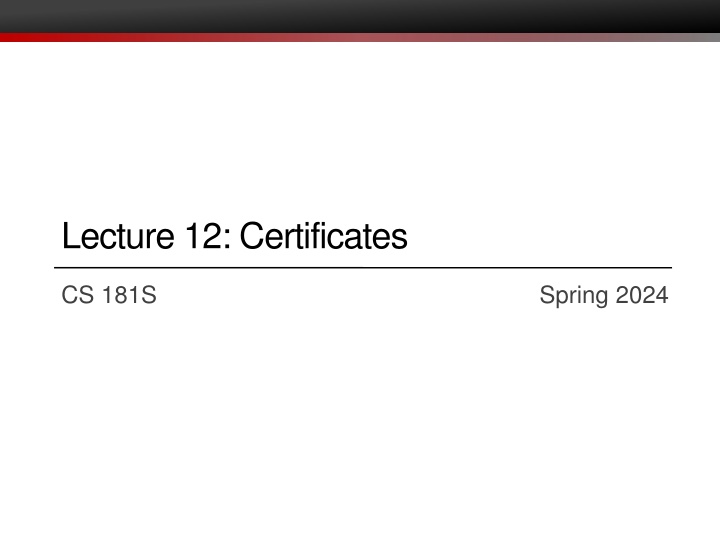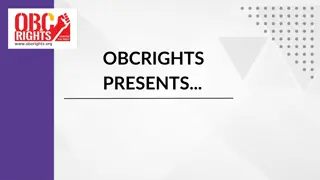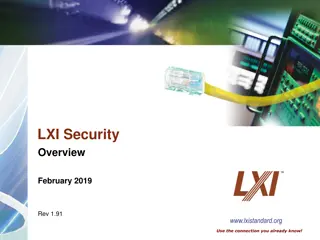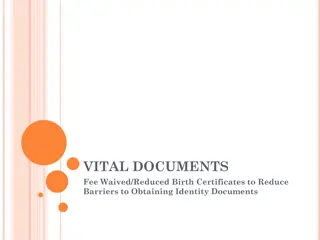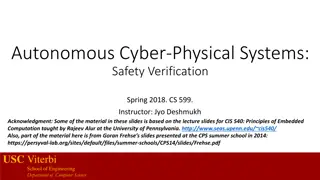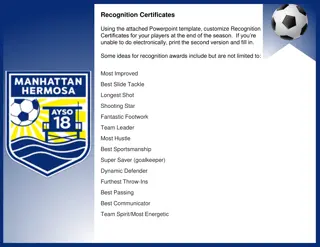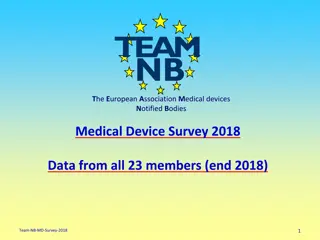Digital Certificates and PKI
Digital certificates play a crucial role in securing online communications through SSL/TLS handshakes. They bind the identity of a principal to their public key, ensuring secure transactions. Public-Key Infrastructure (PKI) manages the distribution of certificates using decentralized or centralized philosophies. Examples like PGP and CAs illustrate different approaches to implementing PKI. Explore the importance and mechanisms behind digital certificates and PKI in this informative content.
Download Presentation

Please find below an Image/Link to download the presentation.
The content on the website is provided AS IS for your information and personal use only. It may not be sold, licensed, or shared on other websites without obtaining consent from the author.If you encounter any issues during the download, it is possible that the publisher has removed the file from their server.
You are allowed to download the files provided on this website for personal or commercial use, subject to the condition that they are used lawfully. All files are the property of their respective owners.
The content on the website is provided AS IS for your information and personal use only. It may not be sold, licensed, or shared on other websites without obtaining consent from the author.
E N D
Presentation Transcript
Lecture 12: Certificates CS 181S Spring 2024
SSL/TLS Handshake ClientHello Version, cipher suites, nonce Version, cipher suite, nonce, certificate ServerHello ServerKeyExchange (optional) ClientKeyExchange Compute master secret Compute master secret ChangeCipherSpec ChangeCipherSpec Encrypted Messages
SSL/TLS Handshake rC, [ECDH, ] Version, cipher suites, nonce Version, cipher suite, nonce, certificate rS, ECDH ?? sign(??) ?? Compute ms_p = ??? ms = PRF(ms_p,rC,rS) Compute ms_p = ??? ms = PRF(ms_p,rC,rS) ChangeCipherSpec ChangeCipherSpec Encrypted Messages
Certificates Digital certificate is a document binding together: identity of principal public key of that principal (might be encryption or verification key) binding together = signed Notation: Cert(S; I) is a certificate issued by principal I for principal S Cert(S; I) = (id_s, K_S, Sign(id_s, K_S; k_I)) Issuer I is certifying that K_S belongs to subject id_S Fingerprint: H(Cert(S; I))
Public-key infrastructure (PKI) System for managing distribution of certificates Two main philosophies: Decentralized: anarchy, no leaders Centralized: oligarchy, leadership by a few elite
PKI Example 1: PGP Uses a decentralized PKI philosophy "Pretty Good Privacy" [Zimmerman 1991] toolset for PKI, encryption, signing of files and emails OpenPGP is implemented by GNU Privacy Guard (GPG) Users manage a keyring: Alice has her own key in her keyring When Alice meets up with Bob at a key-signing party... She copies his key into her keyring She marks Bob as fully or marginally trusted as an introducer And she copies other keys he might have collected, too
PKI Example 2: CAs Uses a centralized PKI philosophy (at least as evolved in marketplace) Invented (?) by Digital [Gasser et al. 1989], used in early Netscape browsers Certificate authority (CA): principal whose purpose is to issue certificates
X.509 certificates [RFC 5280] Contents of certificate: subject distinguished name subject public key (and the algorithm) issuer distinguished name serial number (unique within certs issued by this issuer) validity interval (start and end time) extensions... issuer's signature on the above (and the name of the algorithm)
Finding a useful certificate Certificate chain: sequence of certificates that certify each other on one end, a certificate for the principal you want to authenticate on the other end, a certificate for a principal you already know: the root of trust you must trust every issuer in the chain to issue certificates
A constraint extension "Basic constraint": two values: a Boolean: is this key permitted to be used to verify other certificates? i.e., can it be an issuer's key? At best redundant w.r.t key usage extension, which itself is more precise an integer: number of intermediate certificates permitted to follow this one in a chain ought to be marked critical
Using a CA Your system comes pre-installed with CA's self-signed certificate Cert(CA; CA) When you receive a message signed by Alice: you contact CA to get Cert(Alice; CA) or Alice just includes that certificate with her message
Exercise 1: Using A CA In your web browser, visit a website you frequently use over https Inspect the TLS certificate for that web server: 1) How many certificates are in the certificate chain? 2) Who is the root CA for that certificate chain?
CAs and web browsers Web server has certificate Cert(server; CA) installed Server s identity is its URL CA is a root for which Cert(CA; CA) is installed in browser Browser authenticates web server Using server s URL and public key from certificate
Many CAs There can't be only one No single CA is going to be trusted by all the world's governments, militaries, businesses Though within an organization such trust might be possible So there are many Around 1500 observed on public internet Your OS and/or browser comes with some pre-installed Organizations act as their own CA, e.g.... Company issues certificates to employees for VPN Bank issues certificates to customers Central bank issues certificates to other banks Manufacturer issues certificates to sensing devices
Exercise 2: Root CAs How many root CA certificates are installed on your computer for your preferred browser? Is the root CA you identified in Exercise 1 on that list?
Enrollment with a CA You create a key pair: you do this so that CA doesn't learn your private key You generate a certificate signing request (CSR); it contains the identity you are claiming You send the CSR to a CA, perhaps along with payment The CA verifies your identity (maybe) The CA signs your key, thus creating a certificate, and sends certificate to you
Issuing certificates Conflicting goals: CA private signing key must be kept secret the public verification key is pre-installed on user systems; hard to update if ever leaked, signing key could be used to forge certificates easy way to realize goal: keep it in cold storage CA private signing key must be available for use to sign new certificates when users request them easy way to realize goal: keep it in computer's memory
Issuing certificates Solution: use root and intermediate CAs root CA: the certificate at root of trust in a chain; pre- installed; key kept in highly secure storage intermediate CA(s): certified by root CA, themselves certify user keys; might be run by a different organization than root
Problem 1: Revocation Keys (subject's, issuer's) get compromised Or subject leaves an organization ...certificates therefore need to be revoked There's no perfect solution Fast expiration Certificate revocation lists (CRLs) Online certificate validation
Revocation Fast expiration Idea: Validity internal is short, e.g. 10 min to 24 hr A kind of revocation thus happens automatically Any compromise is bounded Problem: CAs have to issues new certificates frequently, including checking identities Machines have to update certificates frequently
Revocation Certificate revocation lists (CRLs) Idea: CA posts list of revoked certificates Clients download and check every time they need to validate certificate Problems: Clients don't (because usability) Or they cache, leading to TOCTOU attack CRL must always be available (so an attractive DoS target) Chromium does this, with a CRL limited to 250kb
Revocation Online certificate validation Idea: CA runs validation server Clients contact it each time to validate certificate Problems: Clients don't Server must always be available (so an attractive DoS target) Reveals to CA which websites you want to access
Revocation Online certificate validation Follow-on solution: stapling Certificates must be accompanied by fresh assertion from CA that certificate is still valid Whoever presents certificate to client is responsible for acquiring assertion Firefox does this but doesn't hard fail because "[validation servers] aren't yet reliable enough Unless web site has previously served up a certificate to browser with Must Staple extension set
Problem 2: Authority CAs go rogue, get hacked, issue certificates that they should never have issued e.g., Dutch CA DigiNotar (2011), which was included in many root sets: 500 bogus certificates issued, including for Google, Yahoo, Tor Missing a means for authorization of who may issue certificates for which principals
Authority There's no perfect solution Key pinning: upon first connection to a server, client learns a set of public keys for server; in future connections, certificate must contain one of those keys Certificate transparency: maintain a public log of issued certificates; require any presented certificate to be in that log; monitor log to notice misbehavior Certificate Authority Authorization (CAA): piggyback on DNS system; DNS record for entity specifies allowed CAs; a good CA won t issue cert unless they are authorized DNS-based Authentication of Named Entities (DANE): piggyback like CAA; client checks whether cert comes from authorized CA
